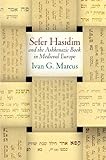"Sefer Hasidim" and the Ashkenazic Book in Medieval Europe / Ivan G. Marcus.
Material type: TextSeries: Jewish Culture and ContextsPublisher: Philadelphia : University of Pennsylvania Press, [2018]Copyright date: ©2018Description: 1 online resource (216 p.)Content type:
TextSeries: Jewish Culture and ContextsPublisher: Philadelphia : University of Pennsylvania Press, [2018]Copyright date: ©2018Description: 1 online resource (216 p.)Content type: - 9780812295009
- 296.3/6 23
- BJ1287.J83
- online - DeGruyter
| Item type | Current library | Call number | URL | Status | Notes | Barcode | |
|---|---|---|---|---|---|---|---|
 eBook
eBook
|
Biblioteca "Angelicum" Pont. Univ. S.Tommaso d'Aquino Nuvola online | online - DeGruyter (Browse shelf(Opens below)) | Online access | Not for loan (Accesso limitato) | Accesso per gli utenti autorizzati / Access for authorized users | (dgr)9780812295009 |
Browsing Biblioteca "Angelicum" Pont. Univ. S.Tommaso d'Aquino shelves, Shelving location: Nuvola online Close shelf browser (Hides shelf browser)

|

|

|

|

|

|

|
||
| online - DeGruyter The Venetian Qur'an : A Renaissance Companion to Islam / | online - DeGruyter Communists and Their Victims : The Quest for Justice in the Czech Republic / | online - DeGruyter Before AIDS : Gay Health Politics in the 197s / | online - DeGruyter "Sefer Hasidim" and the Ashkenazic Book in Medieval Europe / | online - DeGruyter Dante's Philosophical Life : Politics and Human Wisdom in "Purgatorio" / | online - DeGruyter Why Terrorist Groups Form International Alliances / | online - DeGruyter Feeling Time : Duration, the Novel, and Eighteenth-Century Sensibility / |
Frontmatter -- Contents -- Abbreviations -- Abbreviations of Sefer Hasidim Manuscripts -- Introduction -- Chapter 1. Sefer Hasidim as an Open Book -- Chapter 2. Rewriting Jewish Pietist Traditions -- Chapter 3. Judah he-Hasid’s Life and Legends -- Chapter 4. Ashkenazic Hebrew Book Writing in Historical Context -- A Descriptive Catalog of the Manuscripts and Editions of Sefer Hasidim -- Notes -- Select Bibliography -- Index -- Acknowledgments
restricted access online access with authorization star
http://purl.org/coar/access_right/c_16ec
Composed in Germany in the early thirteenth century by Judah ben Samuel he-hasid, Sefer Hasidim, or "Book of the Pietists," is a compendium of religious instruction that portrays the everyday life of Jews as they lived together with and apart from Christians in towns such as Speyer, Worms, Mainz, and Regensburg. A charismatic religious teacher who recorded hundreds of original stories that mirrored situations in medieval social living, Judah's messages advocated praying slowly and avoiding honor, pleasure, wealth, and the lures of unmarried sex. Although he failed to enact his utopian vision of a pietist Jewish society, his collected writings would help shape the religious culture of Ashkenazic Judaism for centuries.In "Sefer Hasidim" and the Ashkenazic Book in Medieval Europe, Ivan G. Marcus proposes a new paradigm for understanding how this particular book was composed. The work, he contends, was an open text written by a single author in hundreds of disjunctive, yet self-contained, segments, which were then combined into multiple alternative versions, each equally authoritative. While Sefer Hasidim offers the clearest example of this model of composition, Marcus argues that it was not unique: the production of Ashkenazic books in small and easily rearranged paragraphs is a literary and cultural phenomenon quite distinct from anything practiced by the Christian authors of northern Europe or the Sephardic Jews of the south. According to Marcus, Judah, in authoring Sefer Hasidim in this manner, not only resisted Greco-Roman influences on Ashkenazic literary form but also extended an earlier Byzantine rabbinic tradition of authorship into medieval European Jewish culture.
Mode of access: Internet via World Wide Web.
In English.
Description based on online resource; title from PDF title page (publisher's Web site, viewed 30. Aug 2021)


